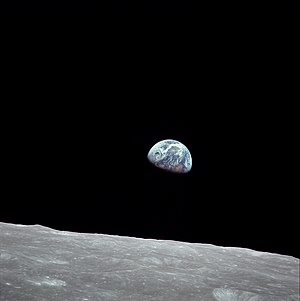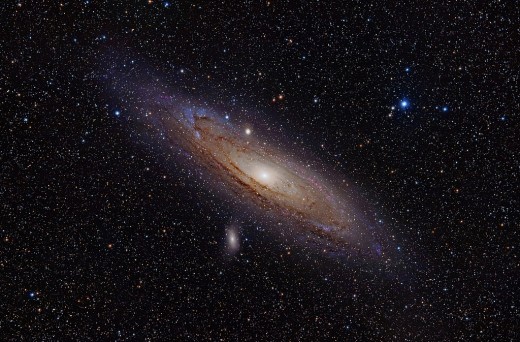Gazing at infinity 'Spaceship Earth'
Our home the spaceship.

Take a moment
Astronomy has always fascinated me, ever since that time sitting on the hill at home, watching the enormous telescope I wrote about in the previous hub (Gazing at Infinity) scanning the heavens, listening to the stars and wondering what they were listening to.
Back then was the time when we first began getting pictures of what the Earth, our home, really looked like from Space, and the picture above was one of the first we ever saw of where we truly are in the universe, and what a stunning picture it was.
I don't know about you folks, but back then all we had at home was a black and white TV, colour wasn't all that popular in the UK, but still, the picture was mindblowing!
For the first time, it was like the Earth was a tiny ball, just suspended in nothing, the vastness that was space, but there she was, a tiny rock teeming with life, and reaching for the stars, but at the time I didn't realise that the rock was actually moving!
Stunning views of earth from various spacecraft, will blow your mind!
The Earth as a Spacecraft?
When you think of our world, what do you think of? Is it a place filled with problems? Wars and all that crap raging on as one man tried to dominate another! Is it a place of incredible beauty that just 'takes your breath away' every time you think of it?
An insignificant ball spinning in a vast emptiness that is space?
Just a few ways you could describe this terrestrial ball we live on, but I want to add another, and I want you to stop and think about this for a moment.
The Earth is a Spacecraft flying through the Universe.
Spaceship earth
Right at this moment, you are moving in at least three directions, and you're moving at three different speeds.
Rotation of the Earth
Rotating East to West the Earth rotates once every twenty-three hours and fifty-six minutes, it's circumference is twenty-four thousand miles (give or take a few miles) and that means that at the equator the earth is moving from East to West at a thousand miles an hour, the further north (or south) you are from it the slower you're going, but most of us are moving at around six or seven hundred miles an hour.
The orbit of the Earth
We are about 93,000,000 miles from our sun. Our orbit isn't a perfect circle and is more of an egg-shaped thing that we do with our nearest point usually during the 'Southern summer' (around Christmas time) but the Northern part feels colder as it's tilted away from the sun (It was thought that the Earth was tilted at 28 degrees, but recent scientific research has shown us that it's actually the sun tilted, and almost all the other planets have the same angle, the reason we'll see as we get further out into the solar system).
We cover a total of five hundred million miles in the space of a year Roughly 1,300,000 miles a day or 57,000 miles an hour, faster than any spacecraft we have eery built, but we aren't finished!
How do we move through the Galaxy?
Interstellar traveler
We aren't done with the moving, you see our solar system is also moving through the Galaxy, what you see as the planets and stars seemingly moving across our sky is only partly true because we are also moving, and as the video shows we're moving at about 200 miles a second. That's 12,000 miles a minute or just under 720,000 miles an hour!
And we can't feel a thing!
By the way, we might be moving in the same direction for the rotation and orbit of the earth, but for the 'biggie' we aren't. We'd be heading North right at this moment, the planets are heading 'up' out of the Galaxy only to be brought back down by the sun's gravity and flung 'south' to repeat the process every year, that' why the Milky Way appears as a band across the sky.
Our Galaxy, if we were to look at it from the outside would look like a massive saucer, it's a hundred thousand light years across, but only about twenty light years from top to bottom, but the way things are shaped the Galaxy is rotating around what we now think is a supermassive Black hole, we're not being pulled into it, but the Black hole is forcing the Galaxy to rotate around, the further out that you get the Galaxy starts to form arms that we call 'spirals' but here's the strange part, we're not in any of those spirals and it's a damn good job!
Meet the neighbours

Take a closer look
We orbit our Galaxy about once every 250,000,000 years. I'm not even going to calculate how fast we're travelling around the Galaxy, but it's Damned fast (more than a million miles an hour) but we're not in those spiral arms and that's a very good thing.
See, in the centre of our Galaxy, and in the arms the stars are packed so tightly together that the radiation from them is so great that it would be highly unlikely that life could ever develop in those star systems!
But how are we moving?
Where's the engine room?
Every spacecraft has an engine room right, Star Trek has Scotty making sure the Enterprise stays in top form, but where is the Earth's?
We're moving around the Galaxy at incredible speed, we're moving around our own solar system as well, but where is our engine room? what is driving our movement?
Isaac Newton discovered what later became known as the law of Gravity, and it's not just 'What goes up must come down' He discovered that as an object spins it creates a force that once accelerated fast enough becomes an 'attracting force'
It's the size or 'mass' of the earth and its spin that creates the force that keeps us on the planet, but it's also Gravity that keeps us in the right place around the sun to allow us to enjoy the warmth of its rays, the size or mass of the earth' along with the force that flung it into space in the first place is what keeps us far enough away for life to occur and stay on the planet.
That Gravity also keeps our sun revolving around our Galaxy AND prevents us from entering those dangerous areas in the spiral arms or the centre of the Galaxy.
This is just one of the amazing things that work in our favour for life on Earth!
But another key is that the gravity can't be too great, there are thresholds that once crossed the force becomes too great for life to be able to develop, and as far as we know Earth is the only place in the solar system where that force is just the right amount, not too much and not too little.
And where are we going with this?
I've got to come clean here before we go much further, spend a few minutes listening to most people talking about the stars and you'll end up thinking life could develop anywhere in the Galaxy, and that just like Star Trek life is rampant throughout the universe, but the reality is very different.
So far we've only explored one thing that is vital for life to develop, and it's not one that's normally talked about, normally they list things like 'The Goldilocks zone' or the presence of liquid water and leave you thinking that life is everywhere, but reality is that scientists know there are around two hundred criteria for life to even begin to develop, and as we go into it we're only going to find one planet that we can find (and we've found over two thousand outside of our own solar system) that fits all two hundred of them, and you're standing (or sitting) on it!








